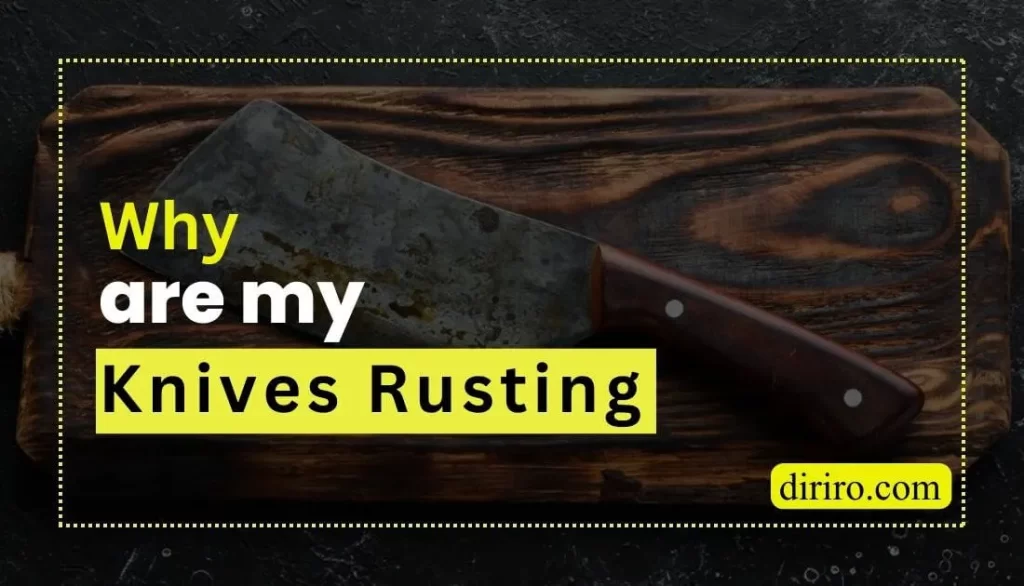If you’ve noticed that your knives are starting to develop rust spots, there are a few possible reasons why. First, it’s important to note that not all types of knives are immune to rusting. Stainless steel knives, for example, are more resistant to rust than carbon steel knives.
However, even stainless steel knives can eventually succumb to rust if they’re not properly cared for.
Rusting occurs most commonly as a result of not properly cleaning and drying knives after use. A knife can corrode if it is left in water or other liquids for a prolonged period of time.
This is especially true if the knife is stored in a damp environment (like a drawer next to the sink).
Another possible reason for rusting knives is that they’re not being properly oiled. Just like any other type of metal, knives need to be lubricated in order to prevent rusting. This can be done by Occasionally wiping down the blade with a light layer of mineral oil.
If you take proper care of your knives and they’re still rusting, they may be simply too old. Over time, even the best-cared-for knives will start to show signs of wear and tear – including rust spots. In this case, the best solution is to simply replace the knife with a new one.
Read Also: Best Kitchen Knife Set Under $300
How to Load Cutlery in the Dishwasher
In order to ensure that your cutlery will not rust in the dishwasher, you must carefully load the dishwasher. The phenomenon of contact corrosion has been proven to occur when metals are placed together.
Keep your stainless steel and silver plated cutlery separate to prevent this from happening. Based on your preference, you may wash them separately or place them in a different area of the machine.
For a more thorough clean, consider using a grid layout, in which you place some items upside down.
Some types of cutlery have wooden handles or plastic handles that should not be put in a dishwasher due to their tendency to be damaged quickly.
Many people also stay away from the dishwasher when it comes to expensive chef knives as well. However, if you follow the steps outlined below, you should not have any problems and these instructions will help.
Using the Dishwasher to Prevent Rusting Cutlery
- Make sure your cutlery is thoroughly rinsed before you use it. Since many foods contain both acid and salt, rinsing cutlery before putting it in the dishwasher will help prevent corrosion. When cutlery is rinsed, it has a greater chance of resealing itself.
- It is recommended to wash the product as soon as possible after use. If you keep cutlery in a dishwasher for an extended period of time it will begin to stain. If they have food remnants on them or have been rinsed but not dried, cutlery is more likely to rust.
- Using excessive amounts of detergent can also lead to rusting. Remember to use the soap container instead of pouring this on your cutlery.
- The cutlery should be removed from the dishwasher immediately after washing and drying.
- Rinsing and holding the dishwasher after using it is the cleanest way to dispose of leftover food.
- As a result of prolonged contact between food remnants, other metals, or water, cutlery will typically become stained. You should be able to keep your cutlery stain-free for a long time if you take the proper precautions. You may also extend the life of your cutlery by buying a better-quality model.
How to remove rust from cutlery
Many people do find rust on their cutlery, even if they know how to prevent it. It is too late to prevent rusting; not everyone is aware of how to prevent it.
Even if you do find rust on your knives and forks, you don’t have to throw them away and buy a new set. There are some simple things you can do to restore your cutlery to the condition they were in when you first bought it.
It might be beneficial to soak rusted cutlery in a mixture of lemon juice or white vinegar before cleaning it so that the rust can be alleviated. The liquid should be put in a glass and allowed to soak for about five minutes.
It should be wiped clean with a cloth after the cutlery has been removed from the liquid. When you’re wiping down your stainless steel cutlery, use a soft sponge, rather than using harsh scourers. As this will leave your cutlery scratched and will also remove the glossy surface, making rusting more likely.
It is important that you follow our prevention instructions after removing the rust stains to ensure that rusting does not occur in the future.
